Check out our range of stock.
Didn't find what you like?
Send us a message
Found something out of stock?
Send us a message
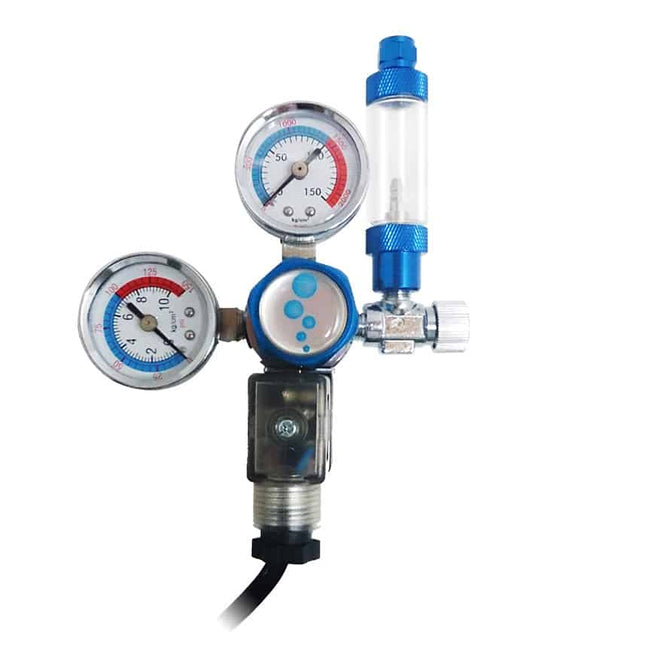
For use with compatible SIDE MOUNT CO2 Refillable Cylinders. Product Features: 1. Depressurized system design with accurate internal structure and refined aesthetic appearance. 2. The outlet pressure of this cylinder is set at 2-3kg/cm2 to eliminate sounds of gas discharging with safety and security. 3. Check valve with bubble counter: prevents backflow into the cylinder with refined aesthetic style. Transparency design is convenient for observation. 4. Energy-saving solenoid magnetic valve operated in low-voltage could operate quietly in a safe environment without temperature rise. Methods of Application 1. First confirm that the thread is appropriate for CO2 cylinder before use. 2. Directly connect the product to CO2 cylinder, fill two third of water for bubble counter before connecting the power, then adjust bubble to 2~5 bubble/second by screwing the knob. 3. Use with timer to set the operating time of light and CO2 system will be convenient to work the aquarium plant system. 4. Use with PH controller can automatically turn on/off CO2 discharging according to the PH value of water. Precautions: 1. Confirmation that the thread is appropriate for CO2 cylinder is required, due to many different specifications of thread in the market. Once damaged, the thread will be ruined beyond repair. 2. To remove this product, shut the CO2 supply off then connecting the power. Turn on the CO2 discharging knob of regulator to evacuate internal air and remove. 3. A complementary O-ring pressure seal is positioned with cable tie. Please store it properly. MADE IN TAIWAN
$249.95

Coconut House Half is a cozy boutique hotel located in the heart of the historic city of Cartagena, Colombia. Our newly renovated rooms are decorated in a contemporary style and are equipped with all the modern amenities needed for a comfortable stay. The hotel is situated close to many attractions, including the beautiful Caribbean beaches, the grand colonial architecture and the vibrant nightlife. Our staff are friendly, knowledgeable and always ready to help with any needs you may have. We offer a variety of services, including a delicious breakfast every morning, a private pool, free Wi-Fi, and a restaurant serving traditional and international dishes. Whether you're looking for a romantic getaway or a family vacation, Coconut House Half is the perfect place to stay.
$9.95
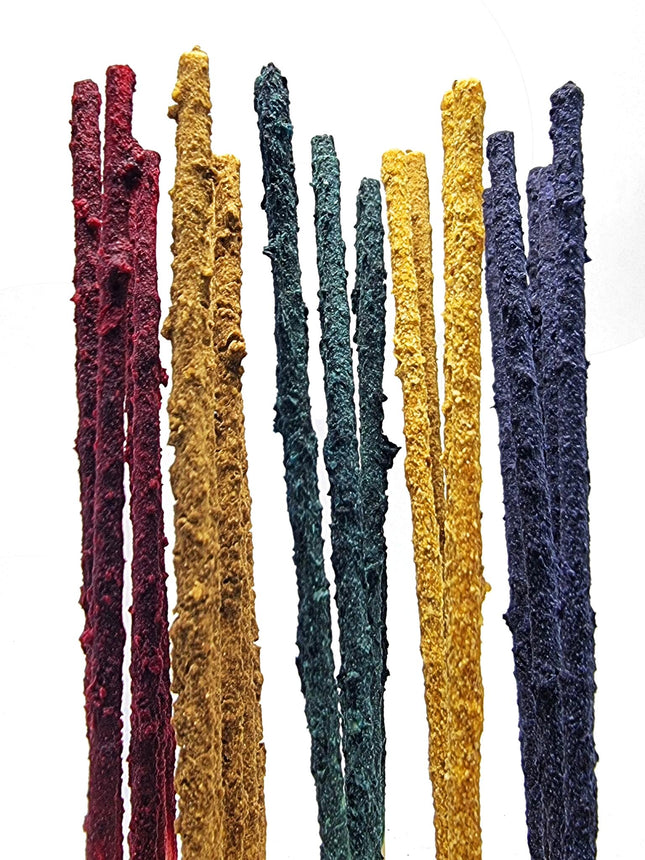
THE SELFIE STICK FOR YOUR SHRIMP Now available in every colour and style Shrimp Pops bring out your shrimp's true colours whilst keeping them strong and powerful for whatever your aquarium ecosystem has to throw at them. Vitamins and minerals for the transfer of proteins The perfect meal for all Caridina and Neo Caridina Moulting will be smooth and seamless Proteins and fats for muscular and skeletal definition All Australian ingredients No preservatives or additives Organic ingredients such as pumpkin, sugar beet, fishmeal, spirulina, astaxanthin and spinach ALL POPS = Protein 40% Fibre 6% Ash 2%PROBIOTIC POPS = Protein 10% Fibre 23% Ash 0% NOTHING TO HIDE LOOK INSIDE
$15.00

Discover the beauty of nature with the Copper Avatar HMPK Female Betta! This dazzling fish features a copper and avatar halfmoon plakat design that's sure to add vibrant flair to your aquarium. Bring a bit of life to your home and enjoy its beauty every day! Fish Head to Tail Size Males: Approximately 3-5cm Females: Approximately 2-3cm Age of Fish: Approximately 2-4 months What you see is what you will get If your beloved pet arrived Dead on Arrival, Please message our friendly team using the Chat Button at the bottom right hand side of the screen with the bag unopened. We will provide a Refund for the fish. The Postage Cost unfortunately is not refundable. Please check our Shipping Policy and Return, Refunds and Exchange Policy for more information. When you are expecting a shipment from us please make sure that there is someone at home that will be able to receive delivery of as we do not provide any refunds if the package is left unattended for more then 1 hour past the delivery time. Did you know that some variations of Bettas like Kois, Grizzles and Fancies will change there pattern in transit and over time? When this happens just be receptive that this will happen and expect the changes. Lastly, we would like to also make sure that your fish reaches you in prime condition, however please note that sometimes long fin varieties can nip at there own tails and this is unfortunately out of our control. Your fish has been kept in Sydney tap water with a temperature of around 23 to 26 C and a pH around 7. Thanks again for looking and if you have any questions please don't hesitate to contact us. Like a specific one? Just send us the picture with your order.
$38.00
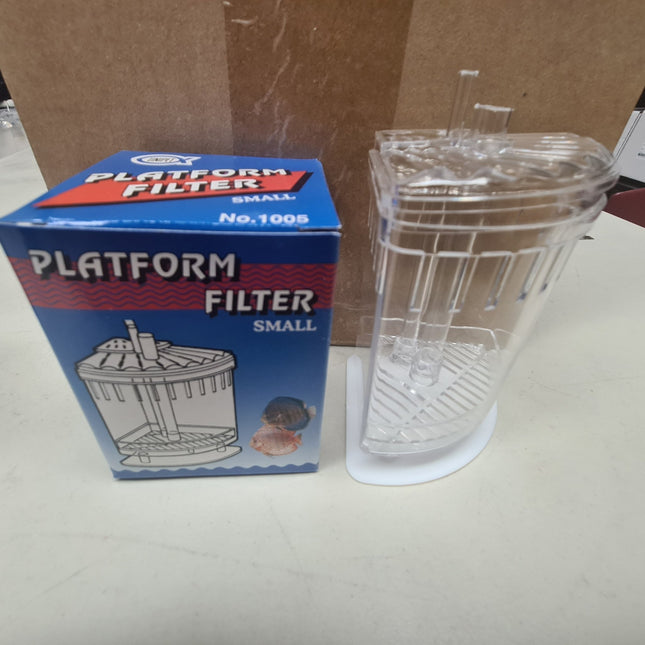
An excellent small air driven filter ideal for aquariums up to 30L When setting up this filter you can run it with filter floss only or in conjunction with media. We recommend the JBL Filter Wool and Marine pure gems to complete the filter set up. You can change the filter wool out whenever it gets dirty and in doing so should keep the media from accumulating debris.
$10.00
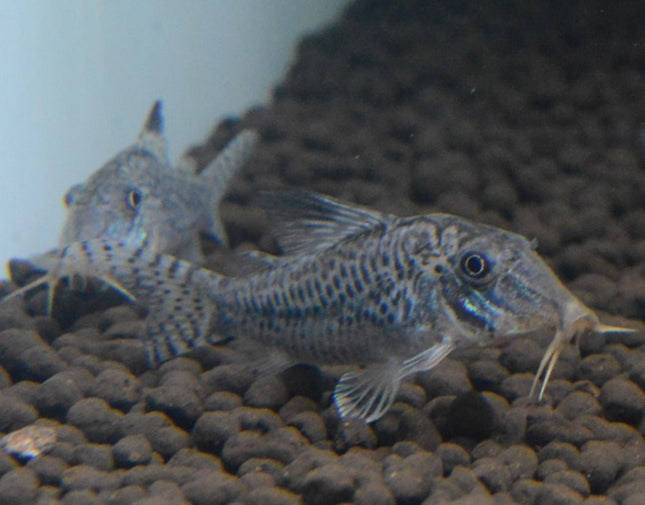
The blacktop corydoras (Corydoras acutus) is a tropical freshwater fish belonging to the subfamily Corydoradinae of the family Callichthyidae. It originates in inland waters in South America, and is found in the Amazon River basin in Ecuador and Northern Peru. It was described by Edward Drinker Cope in 1872. The fish will grow in length up to 1.7 inches (4.4 centimeters). It lives in a tropical climate in water with a 6.0–8.0 pH, a water hardness of 2–25 dGH, and a temperature range of 77–83 °F (25–28 °C). It feeds on worms, benthic crustaceans, insects, and plant matter. It lays eggs in dense vegetation and adults do not guard the eggs. The female holds 2–4 eggs between her pelvic fins, where the male fertilizes them for about 30 seconds. Only then does the female swim to a suitable spot, where she attaches the very sticky eggs. The pair repeats this process until about 100 eggs have been fertilized and attached. The blacktop corydoras is of commercial importance in the aquarium trade industry.
$50.00

Corydoras albolineatus, is a freshwater catfish that is popular among aquarium enthusiasts. This species is known for its peaceful nature and its ability to live harmoniously with other fish in a community tank. Corydoras albolineatus is a relatively small fish, with adults growing to around 2.5 inches in length. They have a distinctive shape, with a broad head and a tapered body that ends in a narrow tail. Their body is covered in rows of bony plates, giving them a unique armored appearance. The albino variety of this species has a white or pale yellow body with pink or red eyes, which makes them an eye-catching addition to any aquarium. These fish are native to the rivers and streams of South America, and they require clean, well-oxygenated water in order to thrive. They are hardy and adaptable, and can tolerate a range of water conditions, although they prefer slightly acidic water with a pH between 6.5 and 7.5. A temperature range of 72-78°F is ideal for this species. Corydoras albolineatus is an omnivorous fish that will eat a variety of foods, including algae, worms, and small crustaceans. They are also known to scavenge for leftover food on the bottom of the tank. It is important to provide a balanced diet for these fish, which can include sinking pellets, frozen or live foods, and fresh vegetables like spinach or zucchini. When kept in a community tank, Corydoras albolineatus are peaceful and social, and they are known for their shoaling behavior. It is recommended to keep them in groups of at least six individuals, as they are more active and feel more secure in larger groups. They are compatible with other peaceful species of fish, but should not be kept with aggressive or predatory fish that may harm them. In summary, Corydoras albolineatus is a fascinating and beautiful fish that can make a great addition to any community tank. They are hardy, easy to care for, and have a peaceful nature. Their unique appearance and shoaling behavior make them a popular choice among aquarium enthusiasts, especially those who appreciate the beauty of freshwater catfish. Thank you for corydorasworld for the image.. Please advise if you like it removed.
$50.00

Corydoras Amandajanea is a South American species of catfish that belongs to the Corydoradinae subfamily. They are a relatively small species, typically growing to around 2-2.5 inches (5-6 cm) in length. The body of the Corydoras Amandajanea is elongated and has a triangular shape. They have a light brown to olive-green base color with dark spots and a white underbelly. The dorsal fin and tail fin of the Corydoras Amandajanea are relatively large compared to their body size. In their natural habitat, Corydoras Amandajanea can be found in slow-moving rivers and streams with sandy or muddy substrates, dense vegetation, and low to moderate water flow. They are native to the upper Paraguay River basin in Brazil and Paraguay. In the wild, they are often found in large shoals, and they prefer to swim and forage in the lower regions of the aquarium. Corydoras Amandajanea are omnivorous, which means that they eat both plant and animal matter. They will feed on algae, small crustaceans, and insect larvae, as well as commercially prepared sinking pellets and flakes. It's important to provide them with a varied and balanced diet to ensure that they receive all the necessary nutrients. Corydoras Amandajanea are relatively easy to care for, making them a great option for beginner aquarists. They prefer water temperatures between 72-78°F (22-26°C), a pH range of 6.0-8.0, and a water hardness of 2-25 dGH. It's important to provide them with plenty of hiding spots, such as caves or plants, to help them feel secure in their environment. A sandy or fine-grained substrate is also recommended as it mimics their natural habitat and allows them to forage for food more easily. Overall, Corydoras Amandajanea is a peaceful and social species that thrives in groups of six or more. They are an active and entertaining fish to watch, and their unique appearance makes them a popular choice for aquarium enthusiasts. With proper care and maintenance, these fish can live for up to 5 years in captivity. If you're looking for a small and easy-to-care-for fish species to add to your aquarium, the Corydoras Amandajanea is an excellent choice.
$100.00

Corydoras Armatus was first imported by a wholesaler in Australia from Singapore. The first time they were imported to Australia successfully was November 2020. According to Eugene Khoo, Armatus had a very low survival rate when shipped. These fish are naturally found in Peru in the tributaries of the Rio Huallaga in the region around Jeberos. The shape of the head is short and compact Their basic colour is grey with a hi fin dorsal fin. The fin spine is darker in colour. All other fins are transparent. Size around 6cm Temperature variations 23 to 26 C
$0.00

Corydoras atropersonatus. Good scavenger with attractive pattern Food: Dry, Frozen, Live - from bottom Temperament: Peaceful & active bottom feeder Care Level: Easiest Temperature Range: 22 - 26 C pH Range: 6.5 - 7.0 Max Size: 5 cm
$34.95

Distribution Type locality is ‘Río Meta, Colombia’, and this species is apparently endemic to that drainage although precise locality details are scarce. There appears to exist evidence to suggest that the type locality is situated in the Río Manacacias basin, Meta Department, near the municipality of Puerto Gaitan. The Meta flows through Colombia, forming the border with Venezuela in its lower reaches before flowing into the Río Orinoco at Puerto Carreño. Temperature: 22 – 26 °C pH: 5.0 – 7.0 Hardness: 18 – 215 ppm
$100.00

DistributionOccurs in tributaries of the coastal rios Guapi, Capivari, and Inbomirim in south-eastern Brazil, between Rio de Janeiro and Santa Catarina.Type locality is ‘Fazenda da Japuhyba near Angra dos Reis, 22°59’S, 44°17’W, Rio de Janeiro, Brazil’.HabitatAlthough found in coastal basins, the fish only occurs in freshwater; this and all species in the genus inhabit small flowing tributary streams and still ponds having a substrate of sand or fine pebbles often covered by mud (Britto & Reis, 2005).Maximum Standard Length90 – 100 mm; the largest of the known Corydoradinae.Aquarium SizeMinimum base dimensions of 120 ∗ 45 cm or equivalent are recommended.MaintenanceIdeally use a substrate of fine sand, although rounded gravel is an acceptable alternative provided it’s kept scrupulously clean.Other décor is largely down to personal choice, but some cover should be provided, particularly if you wish to keep more than a single male.Water ConditionsTemperature: 16 – 24 °CpH: 5.5 – 7.5Hardness: 18 – 215 ppmDietScleromystax spp. are foraging omnivores, and most will accept sinking dried foods as well as small live and frozen varieties such as chironomid larvae (bloodworm), Tubifex, etc. Feeding a varied diet will ensure the fish are in optimum condition.Under no circumstances should they be expected to survive on ‘left-overs’ from other inhabitants of the aquarium or relied on to ‘clean’ the aquarium.Behaviour and CompatibilityTOP ↑Males are aggressively territorial towards one another and cannot be maintained together in smaller aquaria, otherwise peaceful..Sexual DimorphismMale has a white/gold stripe against black on the forehead, more defined spotted pattern on the head and facial bristles like a beard. Females have a more rounded body, particularly when in breeding condition, and are slightly larger.Reference: https://www.seriouslyfish.com/species/scleromystax-barbatus/
$45.00

Fish Profile: Genus Corydoras Species blochi Common name spotback corydoras Wild Origin Nordbrasilen, Guyana, Venezuela Tank Size min. 60 - 100 cm Temperature 22 - 25 °C pH Value 5.0 - 6.0 Fish Size 5-6 cm Food Omnivore Care Sociable, Group, Diurnal
$50.00

Corydoras Brevirostris CW27 Hi Fin is a small, peaceful, bottom-dwelling freshwater fish. It has a short, pointed snout and a short, rounded body with a silver base color and dark gray stripes. Its fins are distinctive for their long, feathery rays and bright orange tips. It prefers well-oxygenated, neutral to slightly acidic water and does best in a tank with plenty of hiding places among plants and driftwood. It is an active, social species that is peaceful with other fish of similar size and temperament. This species is a great choice for the community tank and is an easy fish to keep and breed.
$150.00

Distribution Endemic to the rio Guaporé drainage in western Brazil and northeastern Bolivia, where the river is known as the Iténez. Type locality is given as ‘Main stream of upper Rio Guaporé, Rondônia, Brazil’. Maximum Standard Length 45 – 50 mm. Maintenance Ideally use a substrate of fine sand, although rounded gravel is an acceptable alternative provided it’s kept scrupulously clean. Other décor is largely down to personal choice, but some cover should be provided to give the fish security. Water Conditions Temperature: 20 – 26 °C pH: 6.0 – 7.0 Hardness: 36 – 179 ppm Reference: seriouslyfish
$50.00 $30.00

Corydoras-concolor, commonly known as the Green Cory Catfish, is a freshwater fish native to South America. It is a member of the Corydoradinae sub-family of the family Callichthyidae and is one of the most popular aquarium fish. The Green Cory Catfish is olive green in color and can grow up to 4 inches in length. It has an elongated, streamlined body with a wide head and a small mouth. It has an almost triangular head with two large eyes and two short barbels on each side. The dorsal fin is short and pointed and the caudal fin is divided into two sections. Its lifespan can be up to 10 years in the wild or 15 years in captivity, provided the water is kept clean and conditions are suitable. They are peaceful and social fish, living in small shoals and scavenging for food. They are bottom dwellers and prefer to remain in the lower levels of the aquarium. They are omnivorous and will feed on a variety of foods, such as prepared foods, frozen foods, live foods, and some fruits and vegetables.
$50.00

Corydoras Parallelus c002 Wild Caught 5cm is a beautiful freshwater fish with a unique black and white pattern. The body is a beige color with a black stripe running down the center and white stripes on both sides. The eyes are black, and the fins are clear with a hint of yellow. This fish comes from the Amazon river basin and is a peaceful fish that prefers to live in groups. It is a scavenger that loves to feed on plant matter, small crustaceans, and worms. It is an active fish that loves to explore its environment, and it is a great addition to any aquarium.
$220.00

This Corydoras CW034 Freckled Bolivian Wild Caught is a unique type of Corydoras that comes from the wild in Bolivia. It is a small fish, measuring only 5cm in length, and has a distinctive freckled pattern. Its body is a light yellow-brown color and it has dark brown stripes that run along the length of its body. This fish is a peaceful bottom dweller, and is great for community tanks. It is a hardy fish that does well in groups of its own kind. It is an active swimmer and loves to play in the substrate. This fish is an ideal addition to any aquarium.
$135.00

Corydoras CW51-4cm is a species of tropical freshwater fish native to the Amazon River basin in South America. It is a small, peaceful fish that typically grows up to 4 cm in length. Its body is silver-grey with a light yellow underside and black bands across its face. It is a bottom-dwelling scavenger, known for its social behavior, and is often found in schools with other species of Corydoras. It is an omnivore, feeding on small insects, crustaceans, worms, and plant matter. Corydoras CW51-4cm makes an excellent addition to any freshwater aquarium, and is a great choice for both beginner and experienced aquarists.
$150.00

First Described: Cosline 1940Shape of head: elongated, extended snoutBasic Body Colour: Light Grey BrownCaudal Fin: The caudal fin rays are finely banded brown and white forming eight to ten transverse rows which, however are not particularly vividOther Fins: adipose fin spine has a brown colorationDiscovered in Paraguy in the tributaries of the Rio Paraguai, near Assuncao, Parraguari and SapucaiAppearance: Three ill defined patches of grey blue coloration. The largest is present below the spine and first rays of the dorsal fin. The second, and slightly smaller one is positioned below the adipose fin, and the third and smallest patch is at the base of the caudal fin.Snout region, as well as the belly region exhibits and distinct darker coloration.Coyrdoras Stencephalus is similar in appearence but it has a more ridged back and only two patches instead of 3.
$15.00

Distribution Type locality is ‘Amazon River at Codajás, Amazonas, Brazil’, which is located approximately midway between Tefé and Manaus on the rio Solimões (Amazon) main channel, western Brazil. Its extended range is unclear although similar-looking fish have been exported from Peru on occasion. Maximum Standard Length 40 – 50 mm. Aquarium Size Minimum base dimensions of 90 ∗ 30 cm are recommended. Maintenance Ideally use a substrate of fine sand, although rounded gravel is an acceptable alternative provided it’s kept scrupulously clean. Other décor is largely down to personal choice, but some cover should be provided to give the fish security. Water Conditions Temperature: 20 – 26 °C pH: 6.0 – 8.0 Hardness: 36 – 268 ppm Reference: https://www.seriouslyfish.com/species/corydoras-eques/ Image from: https://www.ornamentalfish.com.tw/wp-content/uploads/2017/07/%E9%9D%92%E9%BC%A0-Corydoras-eques.jpg
$0.00

Corydoras habrosus, also known as the Salt and Pepper Cory, is a small freshwater catfish native to South America, specifically to the upper Orinoco and Negro river basins. They are popular aquarium fish due to their small size, peaceful nature, and unique appearance. Corydoras habrosus have a plump body and grow to be around 1 inch in length. Their coloration is grayish brown with scattered black speckles, resembling salt and pepper, hence their common name. They also have two pairs of barbels on their face, which they use to search for food on the substrate. Corydoras habrosus are peaceful and social fish that are best kept in groups of at least 6 individuals in a well-established aquarium with plenty of hiding spots and open swimming space. They are generally hardy and adaptable fish that can thrive in a range of water conditions, though they prefer slightly acidic to neutral water with temperatures between 72°F and 78°F. They are omnivores and will eat a variety of foods, including sinking pellets, frozen and live foods, and vegetable matter. Temperature: 20 – 26 °C pH: 5.5 – 7.5 Hardness: 36 – 179 ppm Reference Pic from: Here
$17.00 - $20.00

Corydoras leopardus, commonly known as the Leopard Cory, is a small tropical catfish native to South America. It has an elongated body with a broad, flattened head and a large eye. Its back is covered with dark spots while its sides are marked with small, pale spots. It has a dorsal fin that extends from its head to its tail, and pectoral fins that are used for steering and balance. Its coloration ranges from light brown to dark brown, with a yellowish underside. The Leopard Cory is an active and peaceful schooling fish that prefers to be kept in groups of at least six. It is an omnivore, feeding on a variety of foods such as small worms, insects, crustaceans, and vegetable matter. The Leopard Cory is a hardy species that is easy to care for, making it a great addition to any aquarium.
$30.00

Corydoras melanotaenia is a peaceful, small catfish that reaches a maximum size of 3 cm (1.2 inches). It is native to the tributaries of the Amazon River in South America. This species has a black body with a bronze head, and is decorated with a series of yellow stripes along its sides. This fish is a peaceful, shoaling species that should be kept in groups of 6 or more individuals. It prefers an aquarium with plenty of hiding places among plants and other decorations. Corydoras melanotaenia feeds on insects, worms, and prepared foods. It is a great addition to any peaceful community aquarium.
$12.00
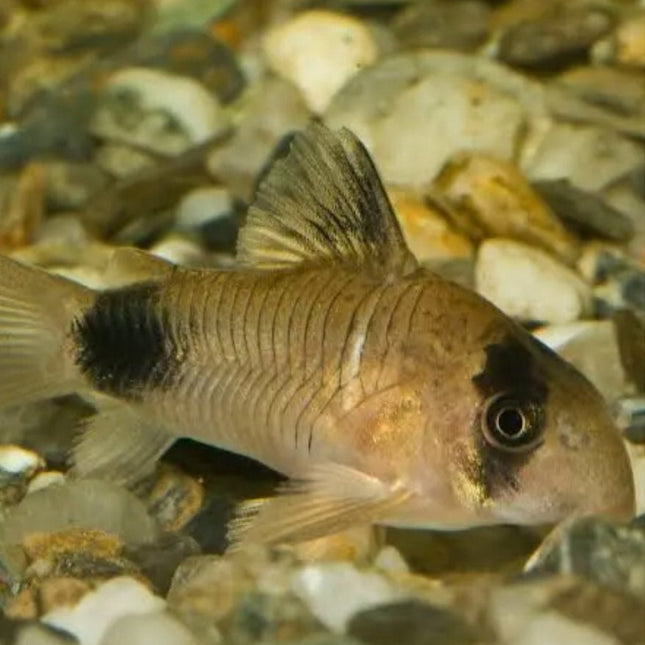
🌿 Calling all aquarium enthusiasts! Say hello to the delightful Corydoras Panda, now available at Nano Tanks Australia! 🐼✨ 🌈 The Corydoras Panda is a charming addition to any nano tank. With its striking black and white markings and playful personality, it's sure to become the star of your aquatic world. 🐼🌿 ✨ These bottom-dwelling catfish not only add visual appeal to your tank but also provide important functions. They are expert algae eaters and diligent scavengers, helping to keep your tank clean and well-balanced. 🌿🐠 📚 Here are some care instructions to ensure your Corydoras Panda thrives in its new home: 1️⃣ Tank Size: Provide a suitable tank with a minimum capacity of 10 gallons to allow for swimming space and proper filtration. 2️⃣ Water Parameters: Maintain a temperature range of 72-78°F (22-25°C) and a pH level between 6.5 and 7.5. Regular water testing and quality maintenance are essential. 3️⃣ Diet: Feed your Corydoras Panda a varied diet of high-quality sinking pellets, flakes, and occasional live or frozen foods. They also enjoy nibbling on blanched vegetables. 4️⃣ Tankmates: Corydoras Panda is peaceful and gets along well with other small, non-aggressive fish. Consider companions like peaceful tetras or small rasboras. 5️⃣ Hiding Places: Provide plenty of hiding spots like driftwood, caves, or dense vegetation to create a secure environment for your Panda Corydoras. 🏢 At Nano Tanks Australia, we take pride in offering top-quality fish for your nano tanks. Each Corydoras Panda is carefully selected for health, vibrant colors, and energetic behavior, ensuring you receive a fish of exceptional quality. 💪🌈 🔍 Explore the joy of owning a Corydoras Panda and witness their graceful movements in your nano tank. Visit our store today or browse our online collection to find the perfect addition to your aquatic family. 🛍️💻 💫 Don't miss this incredible opportunity to bring the delightful Corydoras Panda into your nano tank. Limited stock is available, so secure your adorable specimen today and create a captivating underwater world! 🌟🐠 #CorydorasPanda #NanoTankEnthusiasts #AquaticCharm #PremiumQualityFish #CareInstructions
$20.00 - $30.00

CARE GUIDELINES: Diet: High-quality flake, pellet, and wafer foods as well as frozen foods such as bloodworms and tubifex. Social behavior: Peaceful; requires a school of 6 or more to thrive. Origin: Tank-bred, but indigenous to South and Central America. Average adult size: 2 inches (5 cm) Average purchase size: 1/2 - 1 inch (1.2 - 2.5 cm)
$0.00

Pantana Cory (Corydoras Pantanalensis) C005 Overview: Pantana Cory (Corydoras Pantanalensis) C005 is fast-growing species of Corydoras that are native in the clear water wetlands (Pantanal) in Southern Brazil and Bolivia. The Pantanal is one of the world's most significant wetland habitats. It covers an area of approximately 150,000 square kilometers and is very abundant in water vegetation. Characteristics: Adult c005 is one of Corydora's most attractive fish that can grow up to 8 cm. The adult males show a lovely iridescent spotted pattern when breeding. Pantanalensis Cory is a peaceful and hardy fish. Therefore, they are suitable for most community tanks. However, they should not be kept with a very large or aggressive tankmate. Their perfect tankmates are cyprinids, small characins, dwarf cichlids, and anabantoids. Remember to keep Pantanalensis Cory in a group of at least six individuals as they maintain confidence and activeness in the presence of conspecifics. Feeding: Pantana Corys are carnivores and can eat a wide variety of food, and here are some of them. Brine shrimp Blood worm Chopped earthworm Food that sinks (Algae pellets, catfish pellets) They also eat any dying, dead, or even injured fish that stays on the subtrate for too long. Care: Ideal Tank Size: 30 gallons Water Conditions Temperature: 72 - 79°F (22 - 26°C) PH level: 6.5 - 7.5 Hardness: 5 - 12 Nitrite: 0ppm Ammonia: 0ppm Nitrate: less than 30ppm Breeding: There is no available information for captive breeding.
$100.00

DistributionThe majority of records pertain to the rio Javarí, an Amazonian tributary which forms the border between Brazil and Peru for much of its length and empties into the Amazon main channel in the Três Fronteiras area, where the borders of Brazil, Peru and Colombia meet. It thus seems likely that C. rabauti occurs in both Brazil and Peru, and possibly Colombia, but the full extent of its distribution is somewhat unclear.The type locality is ‘tributary of Amazon River, 7 days by river boat from Manaus, 3°06’S, 60°00’W, Amazonas, Brazil’.Maximum Standard Length55 – 65 mm.Aquarium SizeMinimum tank dimensions of 90 ∗ 30 cm are recommended.Water Conditions Temperature: 20 – 27 °C pH: 5.5 – 7.2 Hardness: 18 – 215 ppm Reference and Image from https://www.seriouslyfish.com/species/corydoras-rabauti/
$20.00 - $30.00

Synonyms None Distribution Upper Caquetá River basin, Colombia. Sexual Dimorphism Mature females will be larger and fuller bodied compared to the males. Maximum Size 5cm (2”) Water Parameters Neutral to soft & acidic, pH: 6.0-7.2, dH up to 15 degrees. Temperature 25-28 deg C (77-82 deg F) Compatibility Community Lighting Medium
$50.00

Temperature: 70-79°F (21-26°C)pH: 6.5-7.5Hardness: 5-12°H
$70.00

The Corydoras Schultzei, also known as the black Corydoras or black-band Cory, is a popular species of freshwater catfish that is cherished by aquarium enthusiasts for its striking appearance and peaceful nature. With its jet-black body and contrasting white bands, this species adds a touch of elegance to any aquarium setup. The black Corydoras is a small-sized catfish, typically reaching an adult size of 2.5 to 3 inches (6 to 8 cm). Its sleek black body is adorned with three distinct white bands that run horizontally along its sides, creating a visually appealing contrast against the dark background. These bands are known to become more prominent and defined as the fish matures, adding to its unique and attractive appearance. In addition to its stunning appearance, the black Corydoras is known for its peaceful and social nature, making it an ideal addition to community aquariums. It is compatible with a wide range of tank mates, including other peaceful fish species, and can be kept in groups of 5 or more for a more natural and active behavior. This species is known to be relatively hardy and adaptable, making it suitable for both beginner and experienced aquarists alike. The black Corydoras is a bottom-dwelling fish that is well-suited for aquariums with sandy or fine-grained substrate, as it enjoys sifting through the substrate in search of food. It is an omnivorous species that will readily accept a varied diet, including high-quality sinking pellets, flakes, frozen or live foods such as bloodworms, brine shrimp, and small insects. This species is native to South America, particularly in the Amazon River basin, and is known to inhabit slow-moving rivers, streams, and flooded forest areas. In the aquarium, it is important to provide ample hiding places, such as caves, PVC pipes, or driftwood, to mimic its natural habitat and provide places for the fish to rest and feel secure. When it comes to water parameters, the black Corydoras prefers slightly acidic to neutral water with a pH range of 6.0 to 7.5, and a temperature range of 72 to 79°F (22 to 26°C). Regular water changes and proper filtration are important to maintain optimal water quality for the health and well-being of the fish. In summary, the black Corydoras (Corydoras Schultzei) is a stunning and peaceful catfish species that can make a captivating addition to any freshwater aquarium. With its striking black body and contrasting white bands, it is sure to be a focal point in any tank. Its hardy nature, social behavior, and adaptability make it a popular choice among aquarium hobbyists. Proper care, including a suitable diet, appropriate tank mates, and optimal water conditions, will ensure the health and happiness of this beautiful species in the aquarium setting. Remember to always source fish from reputable sources and provide them with a suitable and well-maintained environment to thrive. Shop now to add this unique and captivating species to your aquarium collection! Get in touch with us today for expert advice and quality products for your aquarium needs! Buy black Corydoras (Corydoras Schultzei) online now from our reputable store and enhance the beauty of your aquarium with this stunning and unique catfish species! Experience the joy of owning black Corydoras in your aquarium by shopping with us today! Order now and enjoy the beauty and charm of the black Corydoras in your own aquarium! Add the black Corydoras to your aquarium today and experience the beauty and charm of this unique catfish species! Don't miss out on the opportunity to own this captivating
$25.00 - $30.00
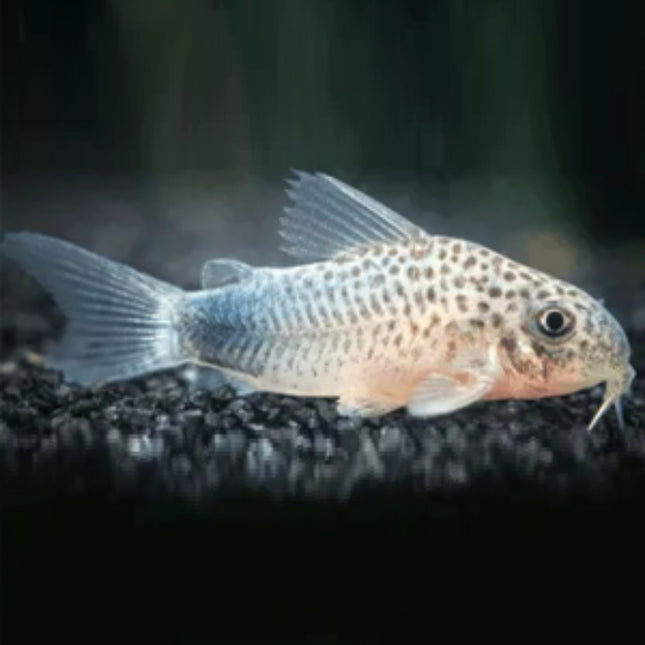
This very lovely and rare Cory Catfish is seldom available, especially tank-bred specimens! The Smudge Spot Cory Catfish (Corydoras similis), also known as the Violet Cory Catfish, is a very uncommon species that is native to Brazil. It is rare in the aquarium hobby, but is in high demand due to the striking dark violet coloration that it develops as it matures. It is a very animated, distinctively marked schooling fish that is perfect for the nano, community, and planted aquarium. The Smudge Spot Cory Catfish is a very peaceful schooling fish that is compatible with most nano aquarium animals, including dwarf cichlids and angelfish. It might prey on some smaller dwarf shrimp, but is safe with larger shrimp and most other peaceful ornamental invertebrates. It is a classic scavenger and will inhabit and feed at the aquarium floor, which should be comprised of sand or smooth gravel. Very coarse substrate can damage its delicate barbels and underbelly, so it should be kept in an aquarium with sand or very smooth gravel substrate. This fish is otherwise undemanding as it will accept most dry,frozen, and live foods. It is adaptable to most tropical freshwater conditions as long as standard regular maintenance is performed and sudden changes are avoided. What We Like About This Fish: Very peaceful and hardy addition to almost any aquarium Compatible with most adult dwarf shrimp and other invertebrates Thrives in schools in well-planted aquaria Distinctive coloration and group schooling behaviour. RECOMMENDED TANK PARAMETERS: Temperature: 68° - 81° F (20° - 27° C) pH: 5.5 - 7.2. Softer water is preferred, but this fish is somewhat flexible as long as sudden changes are avoided. KH: 0 - 15 dKH Minimum tank size: 15 gallons for a school of 6 CARE GUIDELINES: Diet: High-quality dry foods as well as live and frozen meaty foods. Variety is essential. Social behaviour: Peaceful; requires a school of 6 or more to thrive. Origin: Tank-Bred, but indigenous to Brazil Average adult size: 2.4 inches (6 cm) Average purchase size: 1 inch (2.5 cm) Reference and Picture from AquaticArts
$30.00

Corydoras Simulatus, commonly known as the Spotted Rubberlip Pleco, is a small freshwater fish native to the Amazon River basin in South America. It is a member of the family Corydoradinae, and is characterized by its unique spotted pattern on its body. Its coloring ranges from a light tan to a dark brown, and its fins are usually a light yellow or white. Its head is flat, with two large eyes, and its mouth is wide and has small, rounded teeth. The Spotted Rubberlip Pleco is a peaceful fish which is generally found in groups. It feeds mainly on algae and other small food items, such as brine shrimp and bloodworms. They can reach a maximum size of 4 inches, and they live in tanks with plenty of rocks, driftwood and hiding places.
$10.00

The false network catfish (Corydoras sodalis) is a tropical freshwater fish belonging to the Corydoradinae subfamily of the Callichthyidae family. It originates in inland waters in South America, and is found in the Amazon River in Loreto, Peru, and Amazonas, Brazil. The fish will grow up to 1.9 in (4.9 cm) long. It lives in a tropical climate in water with a 6.0–8.0 pH, a water hardness of 2 – 25 dGH, and a temperature range of 72–79 °F (22–26 °C). Source: Wikipedia contributors. (2018, March 21). False network catfish. In Wikipedia, The Free Encyclopedia. Retrieved 01:25, October 19, 2019, from https://en.wikipedia.org/w/index.php?title=False_network_catfish&oldid=831516733
$50.00

CW106 was only recently imported in Australia in March 2021. It is a very hard to find species and harder to identify accurately. The species was wild caught and brought in from an exporter in Columbia. As per the Aquarium Glaser Website: https://www.aquariumglaser.de/en/fish-archives/corydoras-cw-89-cw-91-cw-106-cw-107-2/ The long snouted counterpart of Corydoras sp. CW 107 is Corydoras sp. CW 106, which in turn should be of the same species as Corydoras sp. CW 89. In both species the dorsal band running into the lower caudal lobes is very typical.
$150.00

Corydoras-spp-c91, also known as the Panda Cory, is a freshwater fish native to South America. It is a member of the family Callichthyidae, and is found in the wild in Brazil, Bolivia, Peru, Ecuador, and Colombia. It is a small fish with a black and white patterned body, which gives it its name. The body is usually black with a white spot near the head and a white line running along the back. It has a short, blunt snout and large eyes, giving it a cute look. Its diet consists of worms and other small invertebrates. In the aquarium, it should be provided with a sandy substrate, plenty of hiding places, and an adequate amount of food. It is an active fish and will explore its surroundings. It is peaceful and can be kept in a community tank with other compatible species.
$0.00
You have seen 396 out of 1934 products